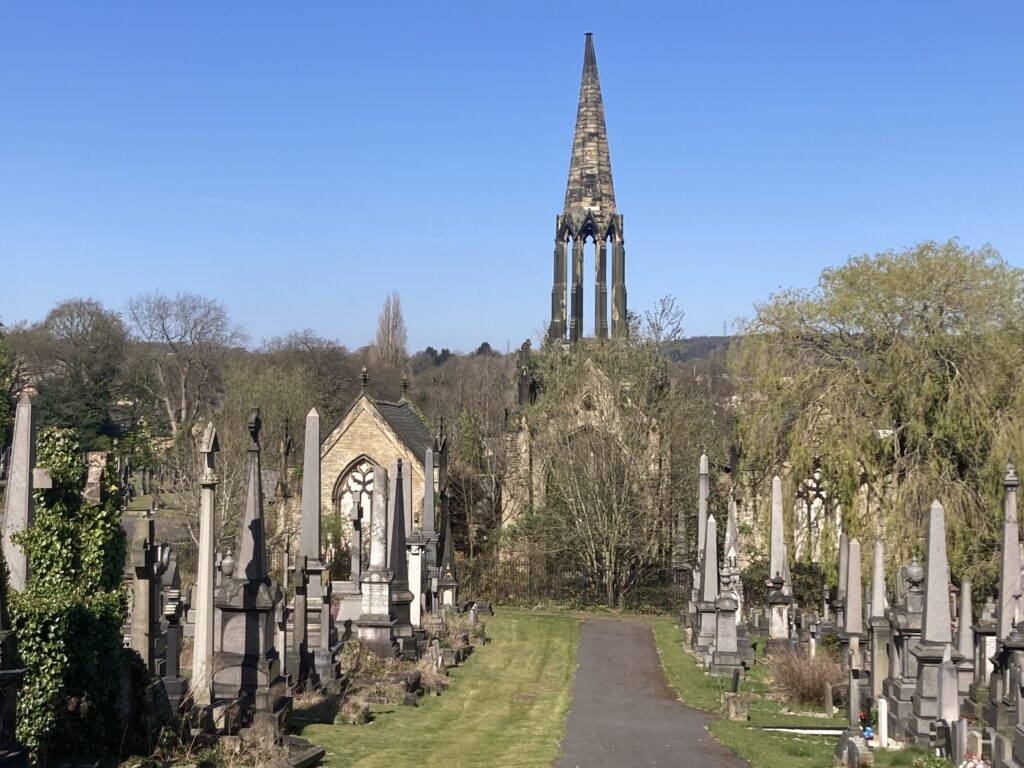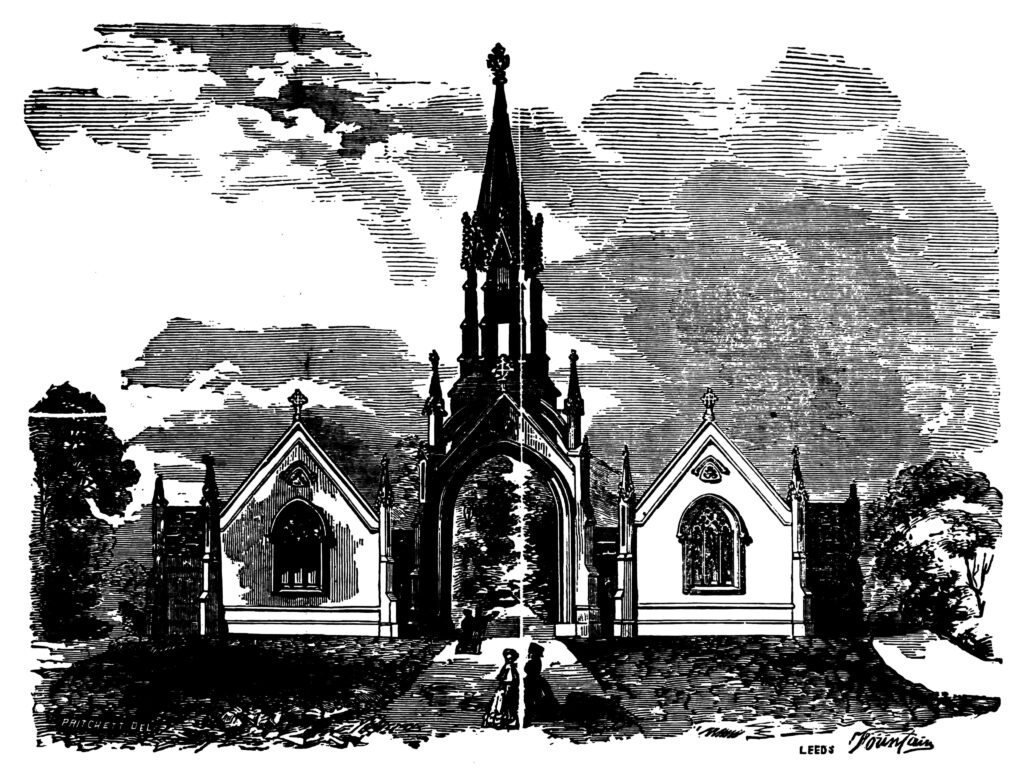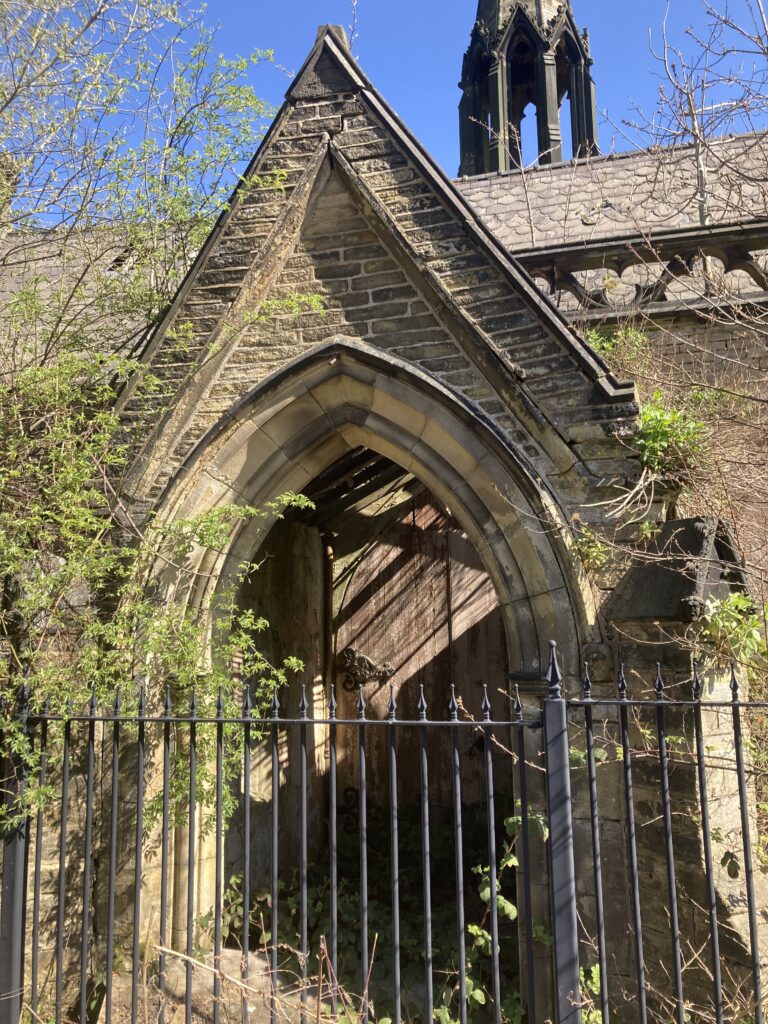
Edgerton Cemetery Chapel Huddersfield. Photograph: Geoff Hughes.
Edgerton Cemetery Chapel, Huddersfield, West Yorkshire, Grade II, James Pritchett, circa 1853 – 1855
This fine, decaying West Yorkshire mortuary chapel has been included on the Society’s Top Ten Endangered Buildings list for 2025. The Victorian Society is making a plea for all cemetery chapels.
Griff Rhys Jones, Victorian Society President, said ‘The Victorians were sometimes at their most flamboyantly imaginative with their cemeteries. Who hasn’t explored their monuments and vaults in awe? This chapel is an important part of this funerary park and could so easily become a dignified centre of its sombre glories again. Out of respect and a sense of good order, we need to see this chapel and, indeed any like it, brought back into the world of the living.’
The burial crisis of the 19th century, driven by soaring mortality rates, reshaped the landscapes of British towns and cities. Overcrowded churchyards, overwhelmed by the dead, forced urgent reform. In Huddersfield, where the parish churchyard alone is thought to have received over 38,000 bodies, complaints about appalling stench and the gruesome disturbance of remains during new interments grew impossible to ignore.
Parliament’s 1850 legislation permitting local authorities to establish burial grounds marked a turning point. Huddersfield’s civic leaders – businessmen, politicians, and journalists – swiftly embraced the opportunity to create a new cemetery, spearheaded by radical reformer Joshua Hobson, Clerk of the newly formed Board of Works. Edgerton was chosen: a site close to existing graveyards, yet far enough from busy streets, with prevailing winds to carry any odours away from town.
Reflecting the Victorian fashion for garden cemeteries, Edgerton was to feature two mortuary chapels – one Anglican, one Nonconformist – allowing mourners to pay their respects before burial. Mortuary chapels, or chapels of ease, served both spiritual and practical needs, offering dignity and reverence to the funeral process. The full cost of the cemetery, including land, landscaping, lodges, and chapels, was £13,000—equivalent to around £1.2 million today.
In March 1853, architect James Pritchett, already known for York Cemetery and Huddersfield Railway Station, was appointed to design Edgerton Cemetery. However, his initial plan – to place the Anglican and Nonconformist chapels in contact – provoked outrage in a climate of intense religious division. Forced to revise his scheme, Pritchett ingeniously separated the two chapels across a central vaulted arch, symbolically and physically preserving their distinct identities.

As funerary customs have changed, many mortuary chapels have fallen into neglect. Edgerton’s once-proud structure, its soaring arch and spire still visible above the trees, now stands in decay. The roof has collapsed, and arson attacks have left the building a tragic ruin.

Vaulted arch between the cemetery chapels in Edgerton Cemetery, Huddersfield. Photograph: Geoff Hughes.

Door to one of the cemetery chapels. Photograph: Geoff Hughes.
In 2009, the Victorian Society called upon the public to help survey cemetery chapels nationwide. Yet the full number of these evocative buildings remains unknown. Some survive in use or are well-maintained; many are boarded up, vandalised, or crumbling. Cemeteries, often vast green spaces at the heart of communities, are chronically underused, and their chapels – built to be welcoming to all – are decaying.
Victorian cemetery designers envisaged that once burial grounds were full, they would evolve into public parks. That vision remains compelling today. The Victorian Society invites a renewed conversation about how we can reimagine these atmospheric spaces and save the remarkable buildings within them for future generations.
James Hughes, Director of the Victorian Society, said: ‘Edgerton Cemetery Chapel is a poignant reminder of the Victorian era’s response to a crisis of profound social and spiritual importance. Today, as this and other cemetery chapels fall into neglect, we must not allow them to be forgotten. The Society calls for renewed attention for these remarkable buildings and the visionary landscapes they inhabit, ensuring they are preserved for future generations to experience and appreciate.’
Another pair of cemetery chapels was placed on the Society’s Top Ten Endangered Buildings List back in 2017, the Ince-in-Makerfield chapels in Greater Manchester, which were designed by Alfred Waterhouse, architect of the Natural History Museum – read more. In 2019 Wigan Council received £100,000 towards restoration, but by 2023 the council were calling for a local friends group to be founded to raise more funds as they said the existing grant was not sufficient to cover the repairs. Other cemetery chapels were added to our Top Ten Endangered Buildings lists in 2018, the Brandwood End Chapels in Birmingham, and in 2012 the Agecroft Chapel in Salford.
The full Top Ten Endangered Buildings list 2025 of Victorian and Edwardian buildings, and the archive of our previous Top Ten lists can be viewed here.

Entrance to one of the chapels in Edgerton Cemetery. Photograph: Geoff Hughes.